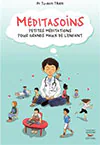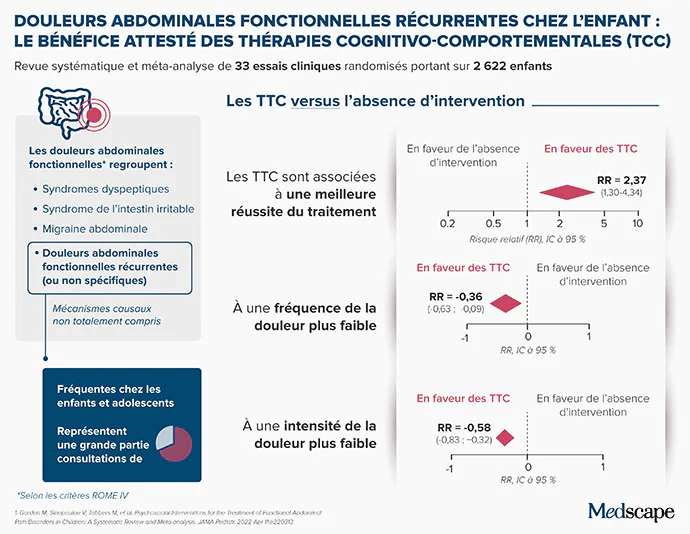Paris, France– A meta-analysis of trials on recurrent functional abdominal pain in children and adolescents concludes in favor of cognitive-behavioral therapies and hypnosis for analgesic purposes[1].This publication confirms the data of the literature as well as the practices, as explained by the Dr Marc Bellaichegastro-pediatrician at Robert Debré Hospital (Paris) in this article.
Pediatric Functional Bowel Disorders
According to current criteria (ROME IV[2]), functional intestinal disorders in older children and adolescents include cyclic vomiting syndrome, constipation, functional nausea, and the group consisting of “functional abdominal pain” where dyspeptic and irritable bowel syndromes coexist. , abdominal migraine and recurrent functional abdominal pain.
Functional abdominal pain is common in children. More than 50% of new patient visits to pediatric gastroenterology clinics meet criteria for one or more functional gastrointestinal disorders and functional abdominal pain accounts for a large proportion of these clinics[3].
“The first step in treatment is to distinguish functional dyspepsia – epigastric pain that worsens when the child eats – from abdominal migraine or cyclic vomiting syndrome, the treatment of which is similar to cephalalgic migraines, specifies Dr. Marc Bellaïche. This diagnosis of exclusion results in “recurrent functional abdominal pain” (or non-specific), a significant proportion of gastro-pediatric consultations. They can seriously affect the lives of children and their families; symptoms often extending into adulthood.
CBT reduces the frequency and intensity of pain
A meta-analysis has just been published[1] on the interest of psychosocial interventions in recurrent functional abdominal pain in children.
Cognitive-behavioral therapy (CBT) is associated with better treatment success and lower pain frequency and intensity in the management of recurrent functional abdominal pain in children.
Cognitive-behavioral therapy (CBT) is associated with better treatment success.
Based on this systematic review and meta-analysis of 33 randomized clinical trials involving 2622 children (median age 12 years (7-17 years); 67.3% female), there is moderate certainty that the fact receiving cognitive behavioral therapy is associated with:
-
increased treatment success (n=324 children; RR, 2.37; 95% CI 1.30-4.34; number needed to treat [NNT] = 5);
-
lower pain frequency (n=446 children; RR, -0.36; 95% CI, -0.63 to -0.09);
-
lower pain intensity (n = 332 children; RR, -0.58; 95% CI, -0.83 to −0.32) than no intervention;
-
as well as similar dropouts due to adverse events compared to no intervention.
Hypnotherapy may also be associated with better outcomes compared to no intervention.
Very real pain that should not be overlooked
This publication does not concern the irritable bowel syndrome or a transit disorder (constipation, diarrhea or mixed) at the origin of the pain felt by the child and on which it is possible to act, in particular pharmacologically.
“On the other hand, in the case of these recurrent (or “non-specific”) abdominal pains, the absence of therapeutic hook (apart from the functional abdominal pains of children “air swallowers”) leaves us helpless, underlines Marc Bellaïche . However, the pain is very real and it is not a question of neglecting it, at the risk that it persists or even worsens”.
In the case of these recurrent (or “non-specific”) abdominal pains, the absence of a therapeutic hook leaves us helpless.
The mechanisms behind recurrent functional abdominal pain are not fully understood. The main theory suggests a dysregulation of the brain-gut communication axis. The interaction and feedback of a variety of genetic, physiological, psychological and environmental factors would thus affect the central nervous system and gastrointestinal motility.
In these so-called somatoform disorders, more than the symptoms, the cause(s) must be treated. These have been well described for about ten years and occur on a particular terrain shaped either by genetics or over time.
“A traumatic event, even modest, can trigger functional abdominal pain in a child with visceral hypersensitivity,” continues the specialist.
A traumatic event, even modest, can trigger functional abdominal pain in a child with visceral hypersensitivity.
These events can take the form of gastroenteritis (post-infectious syndrome, as evidenced by the explosion of functional abdominal pain post-Covid-19), an allergic episode, physical shock, stress linked to a life event (moving, separation, even sexual abuse).
But ultimately, taking care does not depend on the nature of the triggering event. If symptomatic drugs can at least act as a placebo (it has indeed been shown that, in this specific case, the placebo worked in a third of cases), the “positive polarity” has shown its interest, on the model of the “theory of the ice cube” (it is a question of not attacking the pain head on (the ice cube) but of establishing a climate conducive to its reduction (the heat)).
Practicing “Positive Polarity”
“Positive polarity care means recognizing the pathology and its symptoms, prescribing symptomatic medication that will act at least in a good third of cases, and explaining to the child, as to his parents, that the best One of the ways to fight against his pain is not to suffer it but to invest in an analgesic therapeutic project, explains Dr. Bellaïche.
The child or adolescent can thus hope to break the vicious circle of pain, which is identical regardless of the nature of the trigger: when the pain appears, the fear makes it grow, etc. The idea is to cut short this apprehension of pain, by means of distraction. But it is not just a passive distraction but an active involvement, which comes from the individual himself.
To date, as this meta-analysis confirms, the distraction phenomena that have demonstrated a certain effectiveness are self-hypnosis, which requires therapeutic education, meditation, which most often requires a third party, especially in children, and cognitive and behavioral therapy for pain relief. It is adapted to the child”.
The distracting phenomena that have demonstrated a certain effectiveness are self-hypnosis, meditation, and cognitive and behavioral therapy with an analgesic aim.
TTC is the treatment for post-traumatic stress par excellence and recurrent functional abdominal pain is also a kind of post-traumatic stress, occurring in a particular area of hypersensitivity and even in cases of minimal stress.
“This hypersensitivity must be understood as a quality and a skill rather than a damnation that makes the pain unbearable,” he adds. It is then necessary to convince the child that he is the only one to be competent to break the vicious circle of pain, this at the earliest as soon as it manifests itself, by means of a state of trance and meditation, either by self-hypnosis, or distraction using adapted tools and taught during CBT sessions. It is important for the child to take off “the coat of pain” to focus on himself”.
Although useful, this technique is difficult to implement due to the lack of available consultation time (45-50 minutes per session), a certain knowledge of CBT to support children or a formal or informal network of resources. (psychologists, algologists, hypnotherapists, caregivers trained in CBT…).
Consumer meditation applications can help (initiation to analgesic meditation). Books for children and their parents by Pr Tu Anh TRAN (CHU de Nîmes) combine meditation with the situation experienced*.
“This publication validating CBTs and hypnosis in recurrent functional abdominal pain is important in the sense that it confirms the interest of these techniques and specifies what appears in the literature on this subject, indicates Marc Bellaïche, even if the level of proof is not maximum. This is due in particular to the difficulty of conducting this type of study (identifying identical child profiles, etc.), to the subjectivity of the pain assessment scale, to the scarcity of structures or professionals interested in it, as well as the considerable placebo effect”.
This publication validating CBT and hypnosis in recurrent functional abdominal pain is important.
*Professor Tran, head of the pediatrics department at the University Hospital of Nîmes, has been using meditation for more than ten years to treat his young patients.

Chronic illnesses, pain, phobias, eating disorders, hyperactivity, anxiety, school difficulties, sleep disorders… In all these situations, meditation lowers stress and restores inner calm. Meditasoins – Small meditations for major ailments in children Thierry Souccar EDITIONS.
Follow Medscape in French on Twitter.
Follow theheart.org | Medscape Cardiology on Twitter.
We want to say thanks to the writer of this short article for this remarkable web content
Recurrent abdominal pain in children: validated CBTs
We have our social media profiles here as well as other pages related to them here.https://nimblespirit.com/related-pages/

